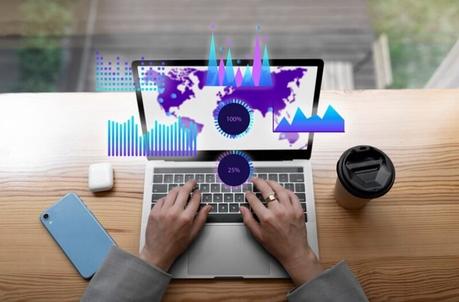
In the ever-evolving world of business, the capacity to anticipate future trends and make well-informed decisions is absolutely indispensable. This is where the art of business forecasting takes center stage, equipping organizations with the ability to strategize, adapt, and flourish. Business forecasting tools serve as the catalysts that propel this process, enhancing its precision, efficiency, and depth of insight. Within this article, we will embark on a journey into the realm of business forecasting tools, unraveling their diverse types, merits, and profiling the leading contenders in the marketplace, all aimed at helping businesses thrive in an increasingly competitive environment.
What is Business Forecasting?
Business forecasting is the process of making educated guesses about future trends and events in the business world. It involves using historical data, various methodologies, and specialized tools to make predictions, helping businesses make informed decisions and plan for the future. With the rapid evolution of technology and the ever-shifting economic landscape, the role of forecasting has become increasingly pivotal in enabling companies to stay ahead of the curve and adapt to emerging challenges.
Why is Business Forecasting Important?
Business forecasting holds immense significance for organizations. It helps in resource allocation, demand planning, and risk management. Accurate forecasts can lead to cost savings, improved operational efficiency, and a competitive edge. Moreover, in an era of global economic uncertainties, effective forecasting empowers companies to navigate turbulent waters, seize opportunities, and build resilience, ensuring their long-term sustainability and growth.
Top Forecasting Tools for Business
Effective business forecasting is crucial for making informed decisions and planning for the future. There are several tools and methods available to help businesses with their forecasting needs. Here are some popular forecasting tools and techniques:
Microsoft Excel
Excel is a versatile and widely used tool for basic forecasting. Its built-in functions, such as moving averages, regression analysis, and exponential smoothing, allow businesses to analyze historical data and make predictions. Excel is a cost-effective option, making it particularly attractive to small businesses with limited budgets. While it may not offer the advanced capabilities of specialized forecasting software, it provides a solid foundation for basic forecasting tasks.
Tableau
Tableau is a robust data visualization tool that goes beyond simple forecasting. It enables businesses to create interactive and customizable dashboards, making data analysis and forecasting more accessible and engaging. Tableau integrates seamlessly with various data sources, allowing users to derive valuable insights and present their findings effectively. Its user-friendly interface and powerful visualization capabilities make it a valuable asset for businesses seeking to enhance their forecasting efforts.
Power BI
Another powerful data visualization tool, Power BI, offers extensive capabilities for data analysis and trend identification. It connects to a wide range of data sources, including databases, cloud services, and spreadsheets, making it a versatile solution for businesses with diverse data needs. Power BI empowers users to create forecasts and predictions, providing a holistic view of their data. This tool's ability to transform data into actionable insights is a key reason why it's widely adopted for forecasting in various industries.
Python
Python is a versatile and widely-used programming language known for its flexibility and powerful libraries. For more advanced forecasting and predictive analytics, Python offers libraries like Pandas, NumPy, and scikit-learn. Data analysts and data scientists frequently use Jupyter notebooks to perform data analysis and visualization. Python's flexibility and extensive library support make it a preferred choice for businesses aiming to tackle complex forecasting challenges.
R
R is a specialized programming language explicitly designed for statistical analysis and data visualization. It boasts an extensive collection of packages tailored for time series analysis and forecasting. Businesses that require in-depth statistical analysis and sophisticated forecasting models often turn to R. Its active community and open-source nature contribute to its popularity among data scientists and statisticians.
SAS
SAS, or Statistical Analysis System, is a comprehensive software suite recognized for its capabilities in advanced analytics, including forecasting. It finds applications in diverse industries such as finance, healthcare, and retail. SAS offers a wide array of statistical and forecasting tools that can handle complex data sets and generate accurate predictions. Its robust features and reliability make it a go-to choice for businesses with extensive forecasting needs.
IBM SPSS
SPSS, or Statistical Package for the Social Sciences, is a statistical software package specifically crafted for data analysis and predictive analytics. It's known for its user-friendly interface and its ability to handle a wide range of data types. SPSS is particularly popular in fields such as social sciences, market research, and healthcare, where robust data analysis and forecasting are critical for decision-making.
Types of Business Forecasts
These forecasts are indispensable tools that empower businesses to anticipate changes, allocate resources efficiently, and make well-informed decisions. Let's delve into the different types of business forecasts:

- Short-Term Forecasting: Short-term forecasting, which looks ahead a few weeks or months, is vital for inventory and staffing management. Businesses rely on tools like Demand Forecasting Software (e.g., Demand Solutions, Forecast Pro, Lokad) for accurate predictions of product demand and Employee Scheduling Software (e.g., Deputy, When I Work) to efficiently schedule staff based on historical data.
- Medium-Term Forecasting: Medium-term forecasting extends the prediction horizon to 1-2 years, supporting budgeting, resource allocation, and strategic planning. Businesses use Financial Forecasting Software (e.g., Adaptive Insights, Prophix) for financial statement and budget forecasts, while Market Research Tools (e.g., SurveyMonkey, Google Trends) provide insights into customer preferences and market trends for medium-term planning.
- Long-Term Forecasting: Long-term forecasting focuses on trends beyond two years and is crucial for strategic decision-making and capital investments. Businesses employ Statistical Analysis Software (e.g., R, SAS, IBM SPSS) for complex statistical analysis and forecasting. Additionally, Scenario Planning Software (e.g., Palisade's @RISK, DecisionTools Suite) helps model future scenarios and evaluate their impact on business strategy.
Benefits of Forecasting Tools
In an increasingly competitive business landscape, the advantages of incorporating forecasting tools into an organization's strategic toolkit are profound. These tools serve as the compass that guides decision-making and resource allocation, offering a multitude of benefits:
Cost Reduction
One of the primary benefits of using forecasting tools is the reduction in forecasting costs. These tools streamline the forecasting process, saving both time and resources. By automating data analysis and prediction, businesses can optimize their forecasting efforts and allocate resources more efficiently.
Data Accuracy
Forecasting tools leverage data analysis and modeling techniques to provide more accurate predictions. This leads to better decision-making and minimizes the risks associated with inaccurate forecasts. Improved data accuracy enhances the organization's ability to make informed decisions and adapt to changing market conditions.
Financial Planning
Business forecasting tools are essential for financial planning. They enable organizations to allocate resources efficiently, create realistic budgets, and make informed investment decisions. By providing insights into future financial trends, these tools contribute to the organization's overall financial stability and growth.

Accurate Scheduling
Accurate forecasts help organizations schedule their operations more effectively. This can lead to optimized production, staffing, and inventory management. By aligning resources with actual demand, businesses can reduce inefficiencies and better meet production and service requirements.
Meeting Customer Needs
By predicting demand and market trends, forecasting tools help organizations meet their customers' needs more effectively. This can lead to improved customer satisfaction and loyalty. Meeting customer needs ensures that products or services are available when and where they are required, enhancing the customer experience.
Realistic Goal Setting
Business forecasting tools assist organizations in setting realistic and achievable goals. They align the organization's resources and strategies with achievable targets. This not only boosts employee morale and motivation but also enhances the organization's competitiveness by ensuring that goals are ambitious yet attainable.
What KPI is Used in Forecasting?
Key Performance Indicators (KPIs) used in forecasting vary depending on the specific goals and nature of the forecast. Some common KPIs include sales growth, revenue projections, profitability margins, inventory turnover rates, customer acquisition costs, and customer retention rates. These KPIs provide valuable insights into a company's performance, helping to assess the effectiveness of the forecasting process. By tracking and analyzing these metrics, organizations can adjust their strategies, allocate resources more effectively, and make informed decisions to achieve their forecasted goals.
Conclusion
In conclusion, business forecasting tools play a crucial role in enabling organizations to make informed decisions, plan for the future, and stay ahead of the competition. By understanding the types of forecasts, the benefits of using forecasting tools, and the key features to look for, you can choose the right tool that aligns with your company's needs. Whether you're a small business or a large enterprise, the right forecasting tool can be a game-changer in your journey towards success. Embracing the power of these tools is not merely an option but an imperative step in navigating the complexities of today's business landscape, ensuring your organization's resilience and prosperity in an ever-changing world.

